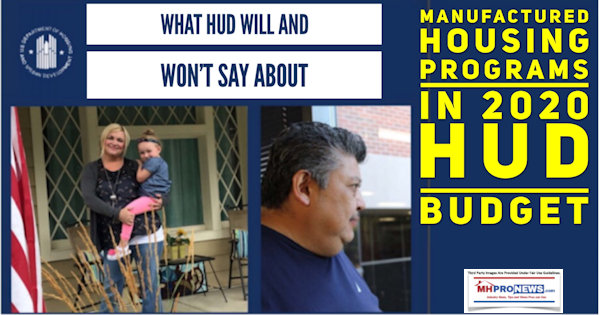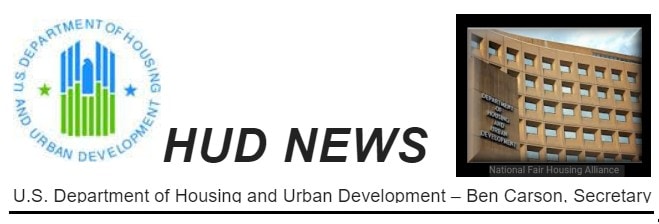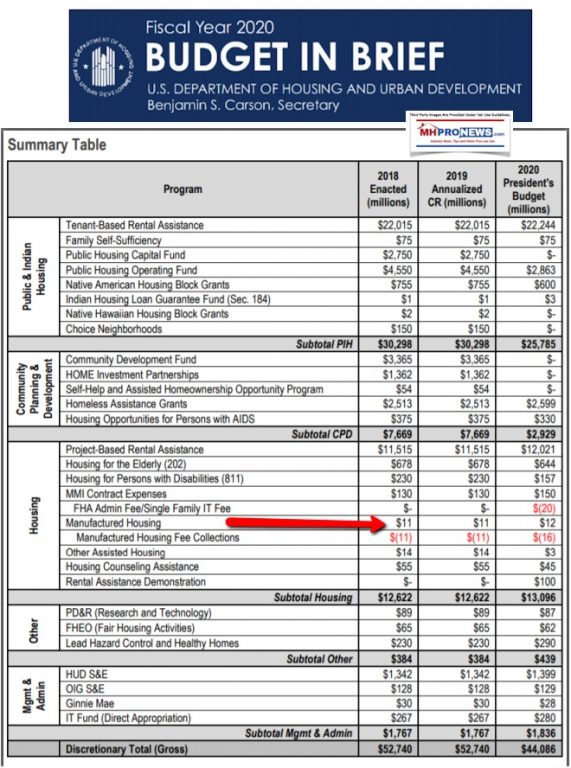
The 2020 federal budget was released today, and their official release to the Daily Business News on MHProNews will follow further below.
But a HUD spokesperson was asked by MHProNews, “How much funding has gone through the HUD voucher program to manufactured home communities and/or for the purchases of manufactured homes?”
Brian Sullivan replied, “I don’t know. Man. Housing is like any form of single-family housing…local PHAs work with tenants/landlords directly.”
Sullivan further stated to MHProNews that “There are no data to show the share of MH participation in our HCV program. Contact PHADA or CLPHA to see what they may say.”
When Sullivan was pressed in a follow up that in the computer age, HUD would lack specific data on what level of federal funds for housing voucher programs go to manufactured home retail or community operations, Sullivan declined to reply. He also said that he had no further information about specifics for the Office of Manufactured Housing Programs (OMHP).
The OMHP part of the massive HUD budget goes, per the 2020 plan, from a meager $11 million to $12 million dollars.
Recall that the Manufactured Housing Institute (MHI) touted the passage of provisions for the use in the voucher program. Now, both HUD and MHI are providing mostly crickets about the specific impact. If the manufactured housing shipment levels for 2018 provide any clue, surely any impact is marginal at best.
With that backdrop, here’s HUD’s full release, which demonstrates that billions are being spent on conventional housing operations. Why aren’t more funds flowing to manufactured homes?
The HUD release includes the full 2020 budget linked as a download. The OMHP budget is found on page 9 of the download.

HUD NEWS
U.S. Department of Housing and Urban Development – Ben Carson, Secretary
Office of Public Affairs, Washington, DC 20410
HUD No. 19-027
March 11, 2019
HUD’S PROPOSED 2020 BUDGET PRESERVES RENTAL SUBSIDIES;
INCREASES HOMELESS ASSISTANCE AND HEALTHY HOUSING
Spending plan preserves rental subsidies; increases homeless assistance and healthy housing
WASHINGTON – The Trump Administration today announced its proposed Fiscal Year 2020 Budget for the U.S. Department of Housing and Urban Development (HUD), a $44.1 billion spending plan that expands resources to prevent/end homelessness; invests record funding to reduce lead and other home health and safety hazards; and preserves rental assistance to HUD-assisted households.
The President’s Budget continues a commitment to fiscal restraint, targeting lower value HUD programs for elimination or reduction, while seeking stable or increased funding into the highest impact programs that provide housing and support for vulnerable populations. Read HUD’s proposed FY 2020 Budget.
“This Budget advances our key priorities, including empowering HUD-assisted families to achieve self-sufficiency,” said HUD Secretary Ben Carson. “For generations, the idea of the Federal Government providing housing assistance meant only one thing—helping to pay the rent so families can have a roof over their heads. But we must also think about how we can help families to access financial programs, educational opportunities, and higher paying jobs. In short, we must think beyond investing in bricks and mortar, and think about investing in people.”
ENDING HOMELESSNESS
The 2020 Budget continues the Federal goal to prevent and end homelessness by seeking nearly $2.6 billion to support thousands of local housing and service programs assisting those living in the nation’s sheltering system and on the streets. This represents a $215 million or 9 percent increase over the Administration’s 2019 budget request.
PROMOTING HEALTHY HOMES
To protect families and their young children from potentially dangerous lead-based paint and other home health and safety hazards, the Administration is seeking a combined $290 million for HUD’s Office of Lead Hazard Control and Healthy Homes. This request doubles the investment the Administration sought last year and represents a historic contribution to State and local governments as they work to remove lead hazards from homes occupied by low-income families with young children who are especially at-risk.
CONTINUING RENT ASSISTANCE
The Budget continues support for 4.7 million HUD-assisted households by increasing rental assistance to $37.9 billion, maintaining support to all current participating households. This request includes $22.2 billion for HUD’s Housing Choice Voucher Program which will allow local Public Housing Authorities (PHAs) to maintain support to approximately 2.2 million families nationwide and represents a 7.6 percent increase over the Administration’s 2019 request. The request also includes $12 billion to renew rental subsidies to privately owned multifamily housing developments through the Project-based Rental Assistance (PBRA)Program, a $874 million increase over the President’s 2019 budget.
The 2020 Budget proposes $644 million for the Housing for the Elderly (Section 202) and $157 million for the Housing for Persons with Disabilities (Section 811) programs. These requested amounts represent an increase of $43 million and $17 million respectively over the President’s 2019 budget request.
PURSUING RENT REFORM
The current rent structure in HUD’s rental assistance programs creates disincentives to employment; imposes large administrative burdens for Public Housing Authorities (PHAs), private owners, and tenants. The Administration believes this structure generates significant and increasing costs to the Federal Government and represents a one-size-fits-all approach that adequately consider local community needs. With the Making Affordable Housing Work Act (MAHWA), submitted to Congress in April 2018, HUD proposed to reform rental assistance to address these issues.
The Budget incorporates the proposed reforms, which promote work, simplify program administration, reduce Federal costs, and increase local choice. These reforms include increased tenant rent contributions for those able to work (not including elderly/disabled households); reduced frequency of income recertifications; and additional flexibilities for public housing authorities and property owners to develop alternative rent structures. In addition, the Budget proposes uniform work for work-able households, while exempting the elderly, the disabled, those caring for a disabled family member or small child, and pregnant women.
PUBLIC HOUSING
HUD estimates that the nation’s public housing stock is experiencing a backlog of billions of dollars in capital needs resulting in the loss of thousands of affordable units each year due to severe disrepair. The cumbersome regulatory structure of the Public Housing program limits local Public Housing Agencies’ (PHAs) ability to adequately address their significant needs. The budget again proposes to merge the Public Housing Capital Fund into the Public Housing Operating Fund with reduced overall funding. This new combined Operating Fund will be given extra flexibilities to pay for capital improvement needs. This better supports local needs by allowing increased flexibility for each PHA to make decisions that best serve their residents.
Meanwhile, HUD will work with local PHAs to shift public housing units to a more sustainable financing model and to allow State and local governments to take a more active role to support these functions. One of these more sustainable models is HUD Rental Assistance Demonstration (RAD). Given the scarcity of federal funds and the substantial capital needs of the nation’s aging public housing stock, the Administration proposes removing the statutory limit on the number of public housing units that can participate in RAD which, to date, has preserved more than 100,000 units of affordable housing that would otherwise have been lost permanently.
SUPPORTING HOMEOWNERSHIP AND FAIR HOUSING
The 2020 Budget continues to support homeownership through the FHA mortgage insurance programs, providing up to $400 billion in new single-family loan guarantee authority that includes critical funding to support targeted improvements to FHA’s aging information technology systems, some of which are based upon the outdated COBOL programming language. In addition, the budget requests up to $30 billion in new loan guarantee authority for FHA’s multifamily, hospital and healthcare mortgage insurance programs.
To further support homeownership opportunities, the Budget seeks $550 billion in new guarantee authority for Ginnie Mae, a part of HUD. Ginnie Mae makes affordable housing a reality for millions of low- and moderate-income households across America by channeling global capital into the nation’s housing markets. Specifically, Ginnie Mae provides significant liquidity, allowing lenders to obtain a better price for their mortgage loans in the secondary mortgage market. The lenders can then use the proceeds to fund new mortgage loans.
As it did last year, the Administration is seeking $62.3 million to support HUD’s fair housing mission.
ELIMINATING/REDUCING INEFFECTIVE PROGRAMS
The Administration continues to seek the elimination of the Community Development Block Grant (CDBG) Program, shifting the activities the block grant program supports to the State and local level. Since 1980, and most recently in 2013, HUD studies found that CDBG is not well targeted to the poorest communities and has not demonstrated a measurable impact on communities. Similarly, the Administration proposes through the Budget the elimination of HUD’s Choice Neighborhoods Initiative, HOME Investment Partnerships Program, and the Self-Help Homeownership Opportunity Program (SHOP), because State and local governments can better meet their communities’ needs.
###
HUD’s mission is to create strong, sustainable, inclusive
communities and quality affordable homes for all.

That’s tonight’s manufactured housing “Industry News, Tips, and Views Pros Can Use” © where “We Provide, You Decide.” © ## (News, analysis, commentary.)
NOTICE: You can get our ‘read-hot’ industry-leading emailed headline news updates, at this link here. You can join the scores who follow us on Twitter at this link. Connect on LinkedIn here.
NOTICE 2: Readers have periodically reported that they are getting a better experience when reading MHProNews on the Microsoft Edge, or Apple Safari browser than with Google’s Chrome browser. Chrome reportedly manipulates the content of a page more than the other two browsers do.
(Related Reports are further below. Third-party images and content are provided under fair use guidelines.)
1) To sign up in seconds for our MH Industry leading emailed news updates, click here.

2) To pro-vide a News Tips and/or Commentary, click the link to the left. Please note if comments are on-or-off the record, thank you.
3) Marketing, Web, Video, Consulting, Recruiting and Training Re-sources

Related Reports:
You can click on the image/text boxes to learn more about that topic.
Democrats, Republicans Agree – “Manufactured Homes Can Play a Vital Role in Easing” the Affordable Housing Shortage – manufacturedhomelivingnews.com
For years here on MHLivingNews and our professional sister site, MHProNews, we’ve worked with a simple premise. Affordable quality living is a non-partisan issue. Rephrased, that means it should be a bipartisan effort to understand and promote the most proven kind of affordable housing that America has ever known.
The First Step to Problem Solving and #HousingChoice – manufacturedhomelivingnews.com
The first step to solving a problem, said the late Zig Ziglar, is to admit that a problem exists. Manufactured homes are widely misunderstood. But why? The facts – when carefully examined – speak well about today’s manufactured homes, as a few video interviews on this page from experts and actual homeowners alike suggests.
The “Need For Quality Affordable Housing Has Never Been Greater,” Says LT – manufacturedhomelivingnews.com
The headline is missing two words from the original that was provided to MHLivingNews by Lending Tree (LT), via a news media release. Those missing two words? ” In Miami.” While that was accurate, it is equally accurate for the vast majority of the U.S. today, thus our edit of those two words.
Affirmatively Furthering Fair Housing, a Novel Yet Proven Solution to the Affordable Housing Crisis That Will Create Opportunities, Based Upon Existing Laws – manufacturedhomelivingnews.com
Affordable quality housing is one of the most critical issues of our time. So too is affordable home ownership, which should be the ideal goal over rental housing. A challenge is zoning and land use, which is highly politicized, and thus is often misunderstood. What follows is adapted from the comments letter addressed as shown below.

























